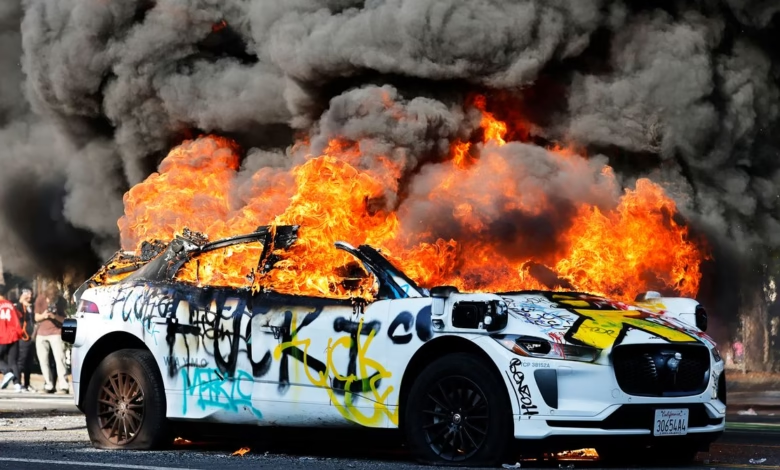Waymo’s Approach to Handling Protest Footage in LA

▼ Summary
– Thousands protested Trump’s immigration policies across the U.S., with vandalized Waymo robotaxis in Los Angeles becoming a symbol of the demonstrations.
– Waymo temporarily halted services in parts of Los Angeles and San Francisco after its cars were set on fire during protests.
– Waymo’s driverless cars have 29 external cameras, raising concerns about surveillance and data collection during protests.
– Waymo shares video footage with police under legal requests but doesn’t disclose how often or the specifics of its compliance.
– It’s unclear whether footage from the burned Waymo cars was destroyed, as the company doesn’t specify where data is stored or how long it’s retained.
Recent protests in Los Angeles have drawn national attention, not just for their scale but for an unexpected development—vandalized Waymo self-driving vehicles becoming a striking symbol of the demonstrations. Five of the company’s robotaxis were set ablaze during the unrest, prompting Waymo to suspend operations in parts of LA and San Francisco. This incident has sparked discussions about surveillance technology and how autonomous vehicle data might be used in law enforcement investigations.
Waymo’s vehicles are equipped with an extensive camera system, featuring 29 external cameras that provide a full 360-degree view around the car, along with internal cameras whose exact number remains undisclosed. These cameras raise important questions about privacy and data retention, especially in situations where footage could be requested by authorities. While Waymo has shared video with police in response to legal requests in the past, the company remains tight-lipped about how often it complies or the specifics of its data-sharing policies.
A spokesperson for Waymo emphasized that the company scrutinizes law enforcement requests to ensure they are legally justified and not overly broad. However, its privacy policy explicitly states that user data may be shared to comply with legal requirements or to ensure public safety. This leaves open the possibility that footage from the vandalized vehicles—if it survived the fires—could be accessed by investigators.
The durability of the data collected by the burned Waymo cars remains uncertain. The company hasn’t clarified whether video feeds are stored locally in the vehicles or backed up remotely in the cloud. Previous statements suggest that interior camera footage isn’t retained alongside external recordings, but retention periods for any footage are not publicly specified.
Autonomous vehicle companies, including Waymo, have historically kept vast amounts of data to refine their technology. However, recent trends indicate a shift toward shorter data retention periods. Still, it’s unclear whether certain types of recordings might be preserved longer than others, leaving room for speculation about what footage, if any, could still be available from the destroyed vehicles.
As debates over surveillance and privacy continue, this incident highlights the growing intersection between autonomous technology and civil liberties. The fate of the footage—and how it might be used—remains an open question with significant implications for both protesters and the future of self-driving car regulations.
(Source: Wired)
